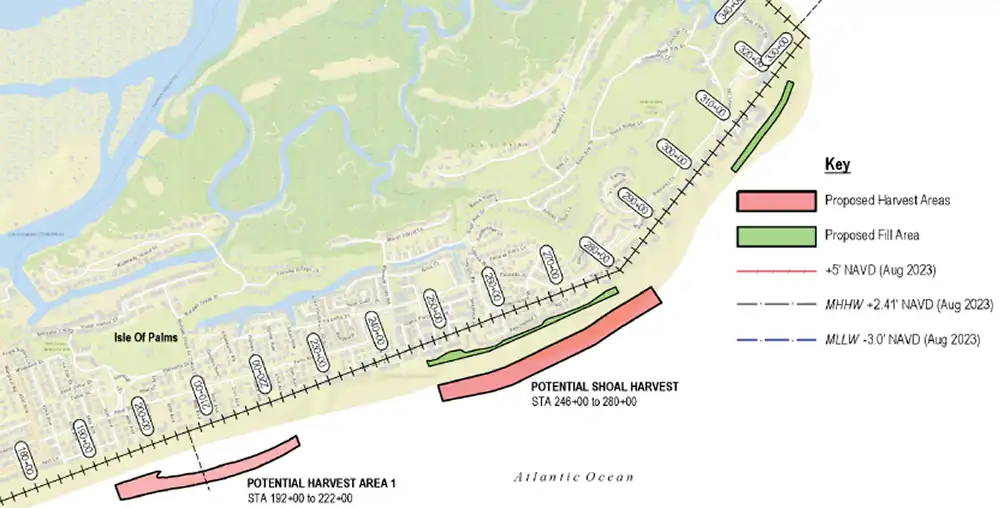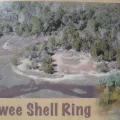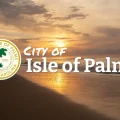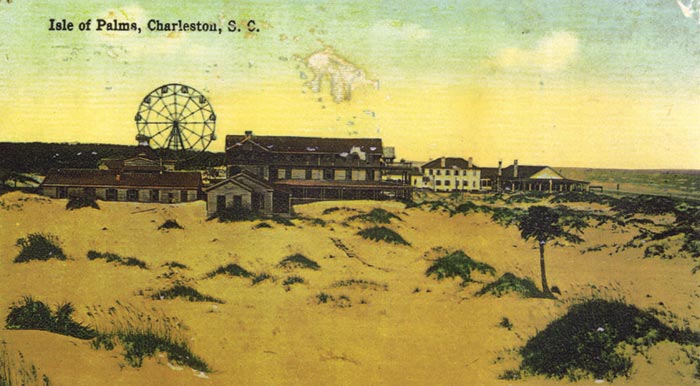
Just off the Isle of Palms, directly in front of Beachwood East at Wild Dunes, a new sandbar shoal is attaching to the beach. The shoal is roughly 350 feet out in the ocean, stretches for approximately 2,500 feet parallel to the beach and is carrying a major load of sand.
In an ongoing effort to keep erosion from wearing away many areas of the island’s coast, IOP city leaders and engineering consultants are hoping to use the sand from this shoal in a future project as a key source of beach nourishment to protect homes, development and of course, the island’s beaches.
“The priority would be to use sand from the offshore shoal that is attaching,” said city administrator Desirée Fragoso. “The project aims to address the challenges and opportunities associated with maintaining and preserving a healthy beach, which is our greatest asset.”
In a public presentation in May at the IOP Recreation Center, Fragoso and coastal engineering consultant Steven Traynum explained project parameters, possible timelines, island coastline history and evolution, monitored areas and previous nourishment efforts to an attendance of more than 60 people.
“There’s a lot of sand offshore at Isle of Palms,” said Traynum, president of Coastal Science & Engineering in Columbia. “We’re looking at how the shoal is attaching right now, and what it’s going to do over the next 12-18 months. That’s going to have a big impact on how many more years we’re going to get out of this particular project.”
Dating back to 1983, the City of IOP has attempted several other largescale beach nourishments, most notably in 2008 and 2018. Other erosion control efforts have included sandbags to protect structures and sand scraping, which involves moving sand from one part of a beach to another.
In his presentation, Traynum showed six beach areas across the island which have been monitored since 2007. South IOP, south Wild Dunes and north Wild Dunes are currently the most eroded areas. “In recent years, erosion has outpaced natural sand flow. We’ve lost about 100,000 cubic yards of sand in these three sections every year from 2008- 2018.”
Traynum added that the east end of the island has lost about “254,000 cubic yards of sand per year since 2018.” That’s an equivalent volume of approximately 78 Olympic-size pools.
However, Traynum pointed out that once the new shoal attaches to the beach, it could add half a million cubic yards to IOP beach nourishment – big enough to keep the east end of the island supplied with sand for the next four to six years.
“The new sand would then be used to replenish the eroded beach areas in front of Wild Dunes Resort, Beachwood East and Dunecrest Lane, and near Wild Dunes Ocean Club at the far east end,” Traynum said. “The background erosion rate is more than the shoal provides in the long term, that’s why periodic nourishment is needed. But if the shoal provides sufficient interim nourishment, we might be able to push a large-scale dredging project further into the future.”
City leaders currently anticipate that beach nourishment projects need to occur every eight to 10 years.
“Right now, we’re looking at a cost of maybe $18-20 million for two largescale projects,” Fragoso said. “Our goal is to coordinate both so that we only pay for the mobilization cost of one. But with a beach preservation fee that generates about $1.5 million every year, there is potentially a gap that the city and city council will need to identify how to meet to make up that gap.”
A permit application for the new sand harvesting project was submitted to the Ocean & Coastal Resource Management (OCRM) in April. If approved, the permit would be valid for five years. Fragoso said that while it is uncertain when the city will hear back from OCRM, “our goal is to secure a permit this fall that would allow a winter permit,” she stated.
And while it is too early to know how much sand the new shoal will yield, plans for harvesting it for beach nourishment include the following:
- Up to two renourishment efforts totaling 400,000 cubic yards of sand.
- Work restricted to winter months.
- Use of land-based equipment, likely requiring two-three months.
- All excavations are limited to wet beach sand. No work in dunes or dry beach sand.
- Majority of beaches will be open to the public during harvesting.
- Harvest areas will contain avenue buffers to limit work too close to structures.
“Given enough time, nature could severely and permanently erode much of the island’s central and eastern areas – which is what we’re hoping this new shoal will help to prevent,” Traynum added. “But if we end up having a lot more erosion and the shoal doesn’t really do a lot for us, then we’ll have to look at alternative measures.”
By L. C. Leach III




Leave a Reply